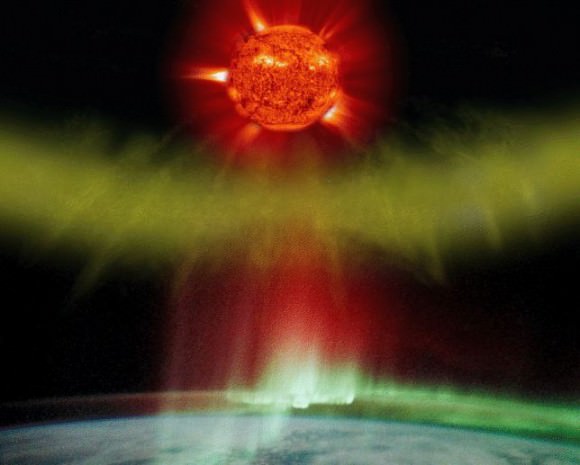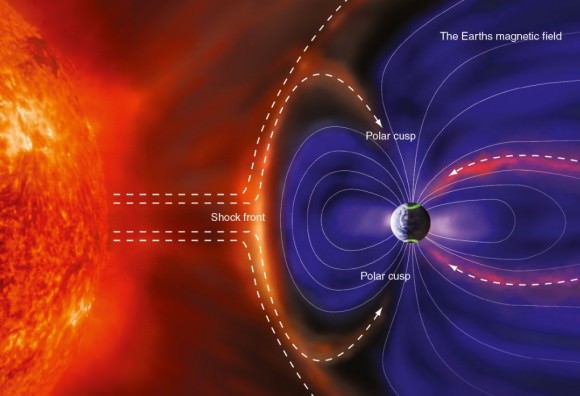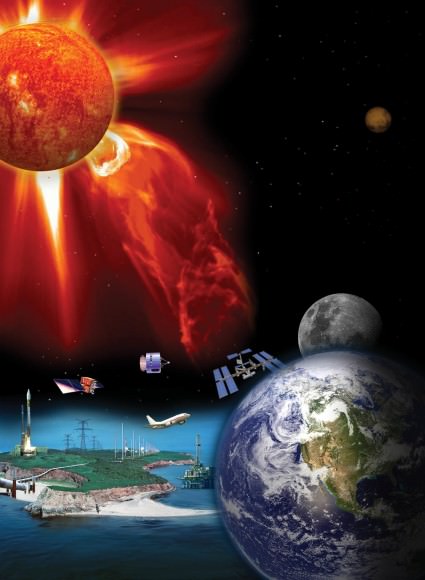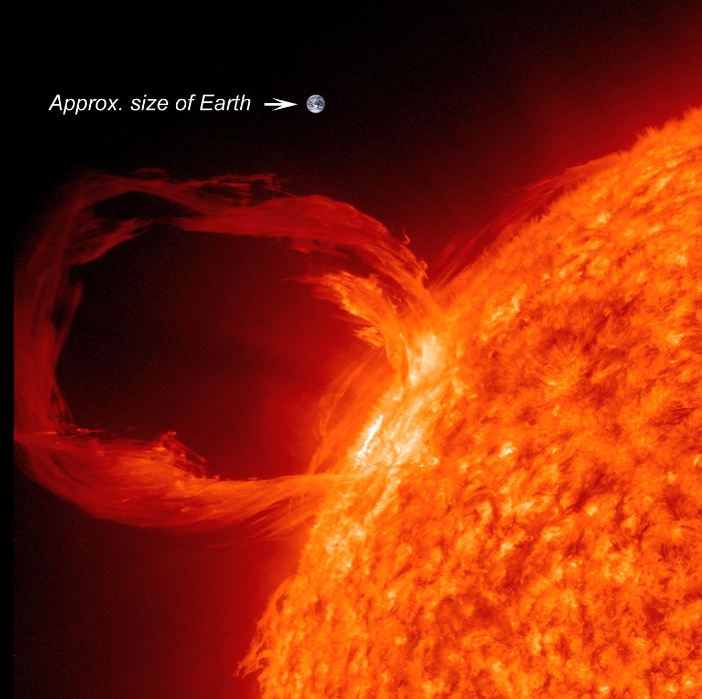Editor’s note: Pål Brekke is a Norwegian solar physicist with a doctorate from the University of Oslo in astrophysics and is now a senior advisor for the Norwegian Space Centre. He has written a new popular science book about the Sun, titled Our Explosive Sun; A Visual Feast of Our Source of Light and Life. Find out how you can win a copy of book here. Brekke has written this guest post for Universe Today.
The Sun has fascinated me for many years. This is perhaps not so strange since I walked my first steps at the solar observatory at Harestua, just north of Oslo. My dad worked there then. During my studies at the University in Oslo my advisors inspired me to spend time doing public outreach. And so it was my interest for sharing knowledge about the mysteries of the Sun that led to my writing this book.
This book presents the properties of the Sun, how it has fascinated humans for thousands of years, and how it affects our technological society. My hope is that this book will inspire an increased interest in the Sun and for natural science in general. The Sun is a perfect entrance to natural science, since it affects the Earth and humans in so many ways. Solar physics interacts with many other scientific fields, such as physics, chemistry, biology, and meteorology to mention a few.
The Sun

Caption: The Sun affects Earth in many ways. Image courtesy of Springer.
The Sun provides energy to all life on Earth and drives the climate system and is therefore very important to all of us. It powers photosynthesis in plants and is the ultimate source of all food and fossil fuel. However, storms on the Sun can also interfere with systems on Earth that our society depends upon.
Looking at the sky with the naked eye, the Sun seems static, placid, and constant. From ground the only noticeable variation in the Sun is its location (where it will rise and set today?). But the Sun gives us more than just a steady stream of warmth and light.

Situated 150 million kilometers away from us, the Sun is a huge thermonuclear reactor, fusing hydrogen atoms into helium and producing million degree temperatures and intense magnetic fields. Near the surface, the Sun is like a pot of boiling water, with bubbles of hot electrified gas. The steady stream of particles blowing away from the Sun is known as the solar wind. Blustering at 1.5 million kilometers per hour the solar wind carries a million tons of matter into space every second (that’s the mass of Utah’s Great Salt Lake).
Every 11 year the Sun undergoes a period of activity called the “solar maximum”, followed about 5 years later by a period of quiet called the “solar minimum”. During solar maximum there are many sunspots, and during solar minimum there are few. Thus, one way of tracking solar activity is by observing the number of sunspots. Sunspots are dark patches like freckles on the solar surface formed when magnetic field lines just below the Sun’s surface are twisted and poke through the solar surface. Sunspots can last from a few hours to several months, and a large sunspot can grow to several times the size of Earth. Though the Chinese recorded some observations as early as 28 B.C., scientists have been observing and recording sunspots since about 1610 when Galileo Galilei pointed his telescope towards the Sun.
Why do scientists care about Sunspots? Because they are visible signs of the turmoil inside the Sun that lead to space weather effects on Earth. Coronal mass ejections (CMEs) and solar flares are often associated with sunspot groups.
Over the next few years more solar storms will occur as the Sun approaches maximum activity in 2013.
Space Weather

Over the next few years more solar storms will occur as the Sun approaches maximum activity in 2013. And that sometimes these storms can cause damages here on Earth? In addition to creating the beautiful aurora, solar storms have many negative effects. The aurora is a manifestation of something violent happening in our atmosphere, where sometimes 1,500 gigawatts of electricity is generated. This is almost double the energy production in Europe!
Solar storms send out large amount of radiation, particles, gas, and magnetic fields into space, sometimes directly towards Earth. We are lucky that we are shielded from most of the hazardous radiation and particles. This is due to our atmosphere that is preventing UV and X-rays from reaching the ground, and our magnetosphere that is deflecting particles. The effects from solar storms are called space weather.
Until about 100 years ago solar storms could pass by without humans noticing much. However, today more than 1,000 satellites are operating in space. Our society depends on having these satellites work properly all the time. We use satellites for weather forecasts, communication, navigation, mapping, search and rescue, research, and military surveillance. The loss of a satellite and its signals can have serious consequences.
Solar storms affect important navigation systems and crucial radio communication. Passenger planes flying over the polar regions can lose radio contact with the flight controller. Satellite phones may stop working, and solar storms can knock out some electricity grids.
About the Author:
Pål Brekke has worked with state-of-the-art space-based solar telescopes since 1985 and has published over 40 peer-reviewed articles, 70 proceeding papers, and more than 30 popular science articles. For six years he was the ESA Deputy Project Scientist for the SOHO spacecraft.


They always portray this as something very scary since it is bigger than Earth, while in reality the mass actually ejected towards Earth would only be the mass of a fully loaded big oil tanker.
Remember, that the mass in a CME, whatever size/energy level it may be, is composed of extremely hot plasma and backed by a stream of million mile an hour ionized protons. Were it not for our magnetic field.. we’d all be crispy toast long ago. When was the last time YOU had a super tanker full of hot plasma and protons land on you? Don’t be afraid.. be very very thankful.
I think you are confusing something hot that causes plasma (shaking the electrons from the atoms loose) and plasma that travelled 1 AU and does not combine with proton/electron since it is too vacuum to have a nearby proton/electron to combine too and therefore stays in a plasma state (and is cold).
The danger of the CME is radiation, not the heat.
The temperature of solar wind plasma around the Earth is about 150,000°K.
The solar wind plasma near the Earth is only about 6 particles per cubic centimeter. Don’t expect it to vaporize the Apollo landers or the LRO.
You are correct, and the upper-upper atmposphere has a region where it is about 2000K hot, but it is practically a vacuum so an astronaut without a suit would still freeze to death.
Well alrighty then, now we’re talking.
Well alrighty then, now we’re talking. The solar wind/plasma travels at an average of about 1,000,000 mph or 160,934,400,000 centimeters per hour. 160,934,400,000 X 6 particles = 965,606,400,000 particles per hour/sq. cm. Humans have a skin area somewhere between 1.5 and 2.0 square meters or divided by 2 = .between 0.57 and 1.0 square meters of exposed skin surface per side… so multiply the number of particles X 1,000 = 965,606,400,000,000 particles per hour. Dang… flash frozen and dessicated crispy critters anyone?
I know that a thousand trillion particles of ionized matter only adds up
to a pittance of actual mass. But still… just like your Ma Ma told you… “If you go outside, you’d better wear some sun screen!”
Since you are on it, tell me how much CME energy is actually stored in a 1 kg mass. And how much energy is radiated back? Don’t ignore the fact that incoming particles have to come to a halt inside that volume to add the kinetic energy. If it passes through then only the delta V must be taken into account.
The difference between the plasma being ejected and the CME far removed from the sun is between a dense collisional plasma and a collisionless plasma. The material in the sun gets pulled by magnetic fields which are wound up in the interior. If the magnetic energy ~ B^2/4??, for B the magnetic field, becomes too large the material can’t contain it. The magnetic field with its plasma is pulled up beyond the solar surface. The are the prominences we see on the sun. This plasma is fairly dense and the protons and electrons scatter off from each other. Some of this material is sent into space, billions of tons of it, and it becomes less dense.
The CME plasma is more of a collisionless plasma. However, the charge of the particles does maintain the CME as a cloud, by some binding potential, with various thermal velocities of these particles relative to moving frame of the CME. These statistical distributions of velocities define a temperature ~ 10^5K or so.
LC
But this high temperature will not vaporize a satellite because of the high temperature if gets exposed to the CME.
The energy of a gas at a temperature T is E = (3N/2)kT, for N = # of atom in some unit of volume and k =Boltzmann constant. The CME cloud is very tenuous so the number density n = N/unit volume is small. So the energy density is small. So while the temperature is fairly considerable the density is so low that it would take a large time for any object to enter thermal equilibrium with the CME. As a result CME don’t melt satellites and so forth.
LC
Saturn has a region where the particle temperature is measured to be about 300.000.000 K, but Cassini seems to have managed quite well :P. As would be expected ofc.
I presume you mean 300,000K. 300 millionK is an inordinately large temperature
LC
No, the particle temperature is actually measured at 300 Millon K, the hottest (measured) place in the solarsystem. Guiness Book of World Records.
Ofc particle temperature is not the common temperature as you showed above, the energy content is still extremely low.
I would like to see a real reference for this.
LC
Here is a link:
http://www.agu.org/pubs/crossref/1981/EO062i047p01154-01.shtml
This link even references higher particle temperatures of up to 1 billion C (which is practically the same as K)
The website fails. I am still skeptical about this. Temperatures in the 10^8 to 10^8 range are in the MeV particle energy domain. This is energy comparable to the solar interior. There must be some mechanism which accelerates particles to this energy. That seems implausible.
LC
Weird that if fails for you, it does not fail for me. But here is a full copy of the text.
EOS, TRANSACTIONS AMERICAN GEOPHYSICAL UNION, VOL. 62, NO. 47, PAGE 1154, 1981
doi:10.1029/EO062i047p01154-01
NEWS
Hot plasma zone near Saturn
Hot plasma zone near Saturn
Peter M. Bell
Carnegie Institution of Washington
Investigators using data collected by Voyager 2 during its flyby of Saturn this past August have found a place in the solar system containing the hottest gas yet observed. Temperatures in a region of space around Saturn range from 300 million to nearly 1 billion° C. The hot gas is an enormous doughnut-shaped region encircling Saturn at an altitude ranging from 273,600 km above the planet’s cloud top to as high as 724,000 km. The discovery was announced at a colloquium at the Applied Physics Laboratory of The Johns Hopkins University, Baltimore, by S. M. Krimigis, chief scientist of the Applied Physics Laboratory Space Department, who is principal investigator of the Voyager Low-Energy Charged-Particle Experiment, which made the observations. The measurements were analyzed by a team that includes investigators from The Johns Hopkins University, the universities of Maryland and Kansas, Bell Telephone Laboratories, and the Max Planck Institute in Germany.
Citation: Bell, P. M. (1981), Hot plasma zone near Saturn, Eos Trans. AGU, 62(47), 1154, doi:10.1029/EO062i047p01154-01.
I should add, obviously there is a possibility for a misttake, but Guiness do not report scientific facts willy-nilly, they always check that it comes from a real scientific paper, and although they probably dont handle any retractions with the same consistency, finding this paper referenced as easy as I did strengthens the validity.
I do agree that it is a remarkable claim.
I recently made a solar projection scope out of an old refractor I own and have been watching the sun with it every day I can. That last big sun spot group was a MONSTER! and now, I can hardly wait to see what comes around the limb next!